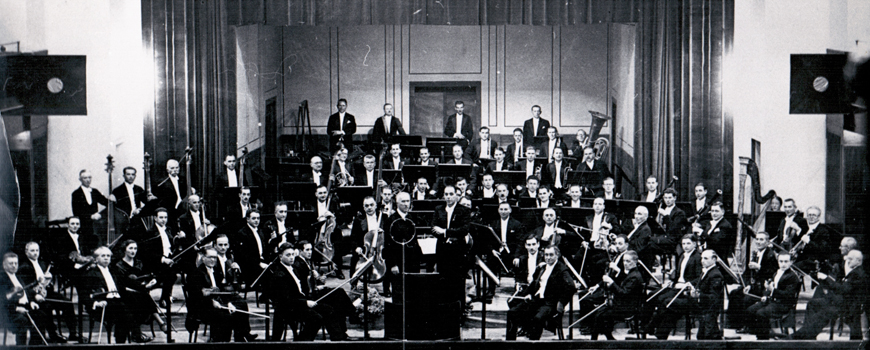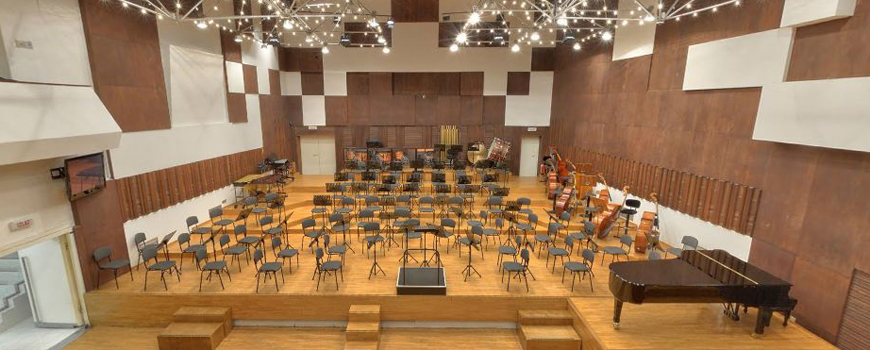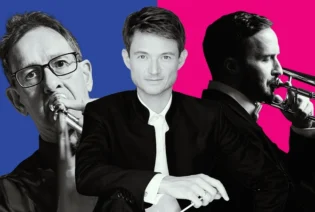
Marking its centennial in 2023, the Belgrade Philharmonic Orchestra is nowadays the leading orchestra in the region and a gust of fresh air on the international concert scene. According to the international media, the Belgrade Philharmonic is Serbia’s cult orchestra (The Financial Times), one of the leading European orchestras (The Independent), an orchestra for which there’s no looking back (The Washington Post), and an ensemble which shows grand dose of heritage and pride (The New York Times).
The orchestra reached a new level of artistic excellence under its most recent Chief Conductor, Gabriel Feltz (2017–2025), realizing numerous landmark projects that have redefined its artistic boundaries.
With a distinctive image of inventive artistic concepts and creative marketing, shaped in the last two decades, the Belgrade Philharmonic has built strong public recognition. Over this period, the BPO has attracted many classical music authorities who supported its further development. Most notably, it has fostered a long-lasting friendship with Zubin Mehta, who first encountered with Belgrade Philharmonic through a concert held in 1958. Following the political changes in October 2000, Mehta became a regular guest and a great friend and supporter of Belgrade Philharmonic, helping the institution to raise awareness about the necessity of making better working conditions for the best ensemble in the region (i.e., acquiring new instruments, and building the long-awaited new hall of the orchestra). During this period he has regularly held gala concerts with the orchestra in Belgrade as well as abroad, including the regional Open Balkan tour held in celebration of the orchestra’s centenary in 2023.
Through its projects, the Belgrade Philharmonic initiates, realizes and supports actions contributing to social progress, promotion of tolerance, regional and international cooperation. The original and unique concept of the New Year’s concert series, promoting ethnic and religious diversity through music, has raised significant attention of the domestic and international public, and it was also acknowledged and supported by the European Union. Led by Zubin Mehta, the orchestra has held its first concert performance in Croatia (Dubrovnik), after the Yugoslav wars. Also, the Belgrade Philharmonic Orchestra initiated and realized a regional cooperation of the three national philharmonic orchestras from Serbia, Croatia and Slovenia, in recent history, under the Pika-točka-tačka (Dot-Dot-Dot) project.
Among the Philharmonic’s most significant recent undertakings were certainly the two concert marathons co-produced with the Dortmund Philharmonic and conducted by their shared Chief Conductor Gabriel Feltz. The Beethoven Marathon took place in June 2022, where the two orchestras alternated performing all nine Beethoven symphonies in a single day. In June 2025, they reunited in Dortmund for the Rachmaninoff Marathon, performing the first three piano concertos and all three symphonies by Sergei Rachmaninoff – in a single day.
Over the past decade, the orchestra has toured extensively, with notable appearances in Italy, Germany, Austria, Switzerland, Sweden, France, Slovenia, Bosnia and Herzegovina, Croatia, North Macedonia, Albania, Hungary, Russia, Oman, etc. The most significant international engagements in the orchestra’s recent history were the first ever U.S. tour, with concerts in the main halls of Chicago, Cleveland, Washington D.C., and New York (2014, Muhai Tang), and China tour with concerts in Xi’an, Weifang, Beijing, and Shanghai (2023, Neeme Järvi).
In 2017, the Belgrade Philharmonic launched its now-traditional open-air concerts, marking a historic milestone as the largest classical music concerts in the Balkans ever held outdoors. More than 30,000 people attended the inaugural performance conducted by Gabriel Feltz, with Zubin Mehta as a special guest. The following year, the Philharmonic broke its own record, drawing over 40,000 attendees to a concert that featured NASA space footage accompanied with classical music, live in concert. With its performance of the iconic Disney Fantasia, the orchestra made history as the first ensemble to ever present this globally famous animated production live before thousands of people at an open-air event.
The orchestra’s programming is further enriched by original educational initiatives for all ages, including open rehearsals for preschoolers and concerts for babies, which remain some of its most beloved features.
In the 2023-24 concert season, the Belgrade Philharmonic celebrated its centenary. Thanks to its landmark projects and artistic excellence, the Belgrade Philharmonic is writing the next pages of its history with great success.

First Steps
In Belgrade, the period between the two world wars was marked by musicians’ attempts to enrich and upgrade the capital city’s artistic life, mirroring the trends in Europe’s largest metropolises. Under the circumstances, an orchestra consisting of musicians of the National Theatre Opera, teachers from Belgrade music schools and a few amateurs, officially named the Belgrade Philharmonic Orchestra, gave its first concert on 13 June 1923. The orchestra’s founder, artistic director and chief conductor was Stevan Hristić (1885-1958), one of the most significant Serbian composers and conductors. During the so-called Hristić period (1923-1936), despite poor working conditions and many problems, the Philharmonic established the system of subscription concerts, with guest appearances of national and foreign artists, and embarked on both classical and the contemporary repertoire of the day.
Following the first international appearance of the orchestra in Sofia, in 1936, artistic leadership of the orchestra was taken over by Lovro Matačić (1899-1985), who significantly contributed to raising the performance level and reputation of the Belgrade Philharmonic, which he continued leading until the beginning of the Second World War. During that period, the audience enjoyed the Belgrade Philharmonic Orchestra’s interpretations of symphonies by Bruckner and Mahler, as well as Handel’s Messiah, Beethoven’s Missa solemnis and the concert version of Wagner’s Parsifal. Those days also witnessed the beginning of cooperation with the orchestras from the region – the Zagreb and Slovenian philharmonic orchestras, which were giving joint concerts in full force. In this period, the orchestra also achieved the first major artistic results, featuring conductors Dimitri Mitropoulos, Josef Krips, pianists Alfred Cortot, Carlo Zecchi, Nikolai Orlov and Nikita Magaloff, violinist Georg Kulenkampff, cellists Pierre Fournier and Enrico Mainardi, as well as singers Zinka Kunc, Bahrija Nuri-Hadžić, Melanija Bugarinović and Josip Rijavec.
Post WWII Years
After the war, during which there were no organised concert activities, a new head of the orchestra was appointed, namely the composer and conductor Oskar Danon (1913–2009), under whose leadership the first post-war concert was held on 7 November 1944, eighteen days after the liberation of Belgrade. The next few years were predominantly marked by concerts organised for special occasions and significant public events.
The orchestra became officially autonomous in 1951, under the name Symphony Orchestra of the People’s Republic of Serbia, with Krešimir Baranović (1894–1975) as the new chief conductor. As soon as the following year, the orchestra reverted to its previous name, the Belgrade Philharmonic Orchestra, which still stands. During Baranović’s ten-year tenure as the director and chief-conductor, the orchestra established itself as an ensemble, with regular performances and subscription concerts, and the first steps towards decentralising the music life were taken, as well. Accordingly, in addition to regular concerts at the Labour Unions Hall and the Kolarac Foundation Concert Hall (where it still performs today), the orchestra also visited culture centres, schools, cinemas and even factories throughout Serbia and made international appearances in Greece, Lebanon, Egypt and Romania. In this period, the Belgrade Philharmonic Orchestra was conducted for the first time by Zubin Mehta, as the laureate of the Liverpool International Conducting Competition (1958). His special connection with the orchestra and deep mutual friendship have lasted until the present time.
Golden Era
Baranović was succeeded in 1961 by Živojin Zdravković (1914–2001), who steered the Belgrade Philharmonic through its so-called golden era, until 1978. In addition to Baranović and Zdravković, the orchestra was also often led by Djura Jakšić and this period saw appearances of many domestic artists, including conductors Bogdan Babić, Dušan Skovran, Mladen Jagušt, Borislav Pašćan and Dušan Miladinović, violinist Branko Pajević, pianists Dušan Trbojević and Andrija Preger, flutist Miodrag Azanjac, clarinettist Ernest Ačkun, as well as vocal soloists Miroslav Čangalović, Milka Stojanović, Radmila Bakočević and Biserka Cvejić. During this period, a series of the nowadays renowned artists made their debut with the orchestra, such as the conductor Darinka Matić-Marović, violinist Jovan Kolundžija, cellist Ksenija Janković and others. As the former Yugoslavia became more open towards the rest of the world at that time, the Belgrade Philharmonic Orchestra welcomed acclaimed international artists, including conductors Rafael Kubelík, Igor Markevitch, Sir Malcolm Sargent, Karl Böhm, Leopold Stokowski, Kirill Kondrashin, Gennady Rozhdestvensky, Zubin Mehta, John Barbirolli, Rudolf Kempe, Charles Dutoit, Neeme Järvi, Aaron Copland, violinists Yehudi Menuhin, David Oistrakh, Isaac Stern, Henryk Szeryng, Leonid Kogan, Gidon Kremer, cellist Andre Navarra, pianists Arthur Rubinstein, Maurizio Pollini, Sviatoslav Richter, Aldo Ciccolini, Gina Bachauer, Emil Gilels, Yvonne Loriod, flutist Jean-Pierre Rampal and others.
In this period, the Belgrade Philharmonic Orchestra also made the most significant guest appearances since its beginnings and introduced itself to music societies with much longer and richer artistic traditions. This included performances in Italy, Austria, East Germany, West Germany, Bulgaria, Hungary, Romania, Czechoslovakia, USSR, Switzerland, United Kingdom, Norway, Mexico and Cuba. Further, the orchestra played at renowned international festivals, such as the Prague Spring Festival, Berliner Festspiele, Festival of the Two Worlds in Spoleto, as well as in Montreux, Bergen and Sofia. These successful appearances also resulted in significant recordings made by the orchestra, firstly for the domestic and, later, for famous international labels such as Philips, Decca and Electrola. Two of its recordings found its way in the Famous Orchestras of Europe series, in which the Belgrade Philharmonic was ranked with the Vienna, Berlin and Dresden philharmonic orchestras, Orchestre de Paris and the New Philharmonia Orchestra London, which were conduced, among others, by O. Klemperer, C. Munch and H. von Karajan. At the time, the Belgrade Philharmonic Orchestra was ranked 5th best European orchestra by international experts – a recognition earned, in part, by its recordings for the eminent international label EMI. In 1970, a recording of Russian arias performed by the famous tenor Nicolai Gedda and the Belgrade Philharmonic Orchestra was awarded the Grand Prix d’ Europe for the best record of the year.
1980s and 1990s
In 1978, Zdravković was replaced as the director, artistic director and chief conductor by his former student Angel Šurev (1932-2004), who held these positions in two intervals, 1978–79 and 1982–1983. The orchestra’s progress was maintained through, admittedly, not as intensive, but still very significant concerts and tours of Italy, Czechoslovakia, Hungary and Bulgaria under Šurev and, later, under Anton Kolar (1942), who worked as the Chief Conductor between 1979 and 1981.
In the mid 1980s, the orchestra was concurrently led by Artistic Director Horst Förster (1920–1987), between 1985 and 1987, and the Director/Chief Conductor Jovan Šajnović (1924–2004), between 1983 and 1989, during which time it successfully toured Austria, Italy, Belgium, West Germany and Spain. Förster’s greatest contribution was in the interpretations of the German romantic concert repertoire, especially of Schumann, Brahms and Beethoven, while, in this period, the orchestra collaborated with conductors Veronika Dudarova, Hans Graf, Vladimir Fedoseev, Cristian Mandeal, violinist Gidon Kremer, cellists Heinrich Schiff and Mstislav Rostropovich, pianists Alexander Slobodyanik, Elisabeth Leonskaja and others. Domestic artists who made their debut before the Belgrade audience at that time were the nowadays famous pianists Aleksandar Madžar, Nataša Veljković and Rita Kinka, as well as violinists Stefan Milenković, Sreten Krstić and Mateja Marinković, to name a few.
In the early 1990s, the already established Russian conductor Vassily Sinaisky (1947) became the head of the orchestra. In one season as the Chief Conductor and Artistic Director (1990/91), he considerably contributed to raising, once again, the orchestra’s artistic level and interpretation quality. The highlights of his tenure include the concert with Mstislav Rostropovich, as well as concerts in Spain, while his further work with the orchestra was interrupted by the civil war. Artists who debuted with the Belgrade Philharmonic during this period were conductor Ivan Fischer, the then young pianist Boris Berezovsky, cellists Stanislav Apolin and Alexander Knyazev and flutist Aurèle Nicolet.
In this period, Branka Cvejić-Mezei, former flutist of the Belgrade Philharmonic Orchestra, took over the management of the institution (1989-1999). She was the first, and so far the only woman at the head of this institution. In comparison to the previous practice, which implied that the leading figure of the institution was the chief conductor who was often simultaneously the artistic and administrative manager, with her arrival at the position of general manager, a new phase in the institution’s functioning began, in which a clear distinction was made in terms of the distribution of responsibilities.
The years of conflict in the Balkans drove the Belgrade Philharmonic to the margin of European concert activities. Nevertheless, the orchestra’s following Chief Conductor Emil Tabakov (1947), during the four seasons in which he held this position (1994–1999), succeeded in maintaining a commendable level and establishing a close relationship with the musicians, as well as with the Belgrade audience and critics. In those dark and dismal times for Belgrade and Serbia, a number of conductors made their first appearance with the orchestra, a cooperation that continued in the subsequent years, as well. They were Petr Vronsky, Gyula Németh, Konstantin Krimetz and Cristian Mandeal, as well as baritone Željko Lučić, one of today’s most famous Serbian artists, violinist Nemanja Radulović and pianist Tamara Stefanović. As there were practically no funds for culture, working conditions deteriorated, so the institution also faced serious technical problems, while the stock of run-down instruments was reduced to amateur quality level.
The New Millennium
The period starting with the bombing of Serbia in 1999 and stretching until 2001, with Pavle Medaković as the orchestra’s director, was surely one of the grimmest in the history of the Belgrade Philharmonic. During that time, until the political changes in late 2000, the orchestra had no organised concert season, but only gave sporadic performances without a single notable conductor or soloist. At the invitation of the newly appointed Director Ivan Tasovac (1966), who held this position from 2001 to 2013, Uroš Lajovic (1944) became the new Chief Conductor. A regular guest of the orchestra in almost every season since 1977, Lajovic stayed in the orchestra from 2001 to 2006. This period was marked by a radical shift in the functioning of the institution and the work of the orchestra, which gradually put the Belgrade Philharmonic back on the map of major European orchestras. This trend also included a generational shift among the musicians, where young artists, age 28 on average at the time, educated in music centres around the world, returned to Serbia and created a new image of the orchestra. Belgrade once again became attractive for renowned international artists, such as conductors Zubin Mehta, Jiri Kout, Bruno Weil, Kirill Petrenko, Leopold Hager, En Shao, violinists Renaud Capuçon and Nigel Kennedy, cellists Gautier Capuçon and Gary Hoffman, pianists Nikolai Lugansky and Denis Matsuev, hornist Radovan Vlatković, clarinettist Paul Meyer, percussionist Evelyn Glennie and others. The orchestra had guest appearances in Slovenia, Austria and Italy. The subscription-based organisation of concerts was reformed and the ticket sale system was improved. In the season 2003/04, the orchestra returned to its renovated and newly equipped building, featuring a concert hall with 201 seats. In the season 2005/06, a fund for the purchase of new instruments was established at Zubin Mehta’s initiative, named after the eminent conductor. With the help of donations from the public budget, as well as from private sponsors and donors, more than €1.5 million has been invested in new instruments, to date.
When the Chief Conductor Lajovic left service, this position was briefly held by Dorian Wilson (1964), who introduced works from the American music literature into the orchestra’s standard repertoire. After a lengthy pause in international activities, it was under his leadership that the orchestra went on its first major tour of Sweden and made its first post-war guest appearance in Sarajevo.
In the following years, the Belgrade Philharmonic collaborated with many acclaimed international artists, including conductors Krzysztof Penderecki, Muhai Tang, Sir Neville Marriner, Asher Fisch, violinists Sarah Chang, Ivry Gitlis, Liana Isakadze, Isabelle Faust and Gilles Apap, cellists David Geringas and Sol Gabetta, pianists Gerhard Oppitz, Andrei Gavrilov, Barry Douglas, Elisabeth Leonskaja and Jean-Yves Thibaudet, trumpeters Gabor Boldoczki and Sergei Nakariakov, horn player Radek Baborak, oboist Alexei Ogrintchouk and others. After several successful performances with the Belgrade Philharmonic, the position of the Chief Conductor was entrusted to Chinese conductor Muhai Tang, who held this position from season 2010/11 until 2014/15.
Starting with the season 2017/18, Chief Conductor of the Belgrade Philharmonic Orchestra is Gabriel Feltz, and from the same season Principal Guest Conductor will be Daniel Raiskin.
By taking an innovative approach to the selection of concert cycles and individual programmes and by raising the quality of its interpretations, the Belgrade Philharmonic Orchestra has lately considerably increased the number of its subscribers and has enriched its repertoire by introducing pieces previously unheard by the Belgrade audience, as well as new compositions shortly after their world premieres. As a result of these efforts, the Belgrade Philharmonic is the leading orchestra in the region, whose concerts are sold out several months in advance.
The orchestra has appeared under conductors Mikhail Yurovski and En Shao, Gabriel Feltz, Jane Glover, Eiji Oue, Howard Griffiths; with pianists Fazil Say, Simon Trpčeski, Lilya Zilberstein, Eliso Virsaladze, Nelson Freire, Boris Berezovsky, Andrei Gavrilov; violinists Julian Rachlin, Sergei Krylov, Vadim Repin, Nemanja Radulović; cellists Mischa Maisky, Antonio Meneses, Miklós Perényi, Steven Isserlis, Mario Brunello, Johannes Moser, Maja Bogdanović; guitarist Sharon Isbin; flutist Emmanuel Pahud; harpist Xavier de Maistre, the duo Igudesman & Joo etc.
In addition to a large Italian tour towards the end of 2011, the orchestra also turned its focus to renewing its regional concert activity – in Slovenia and Croatia. The concert in Dubrovnik, under Zubin Mehta and featuring Julian Rachlin, was its first visit to Croatia after almost 30 years. At the same time, beside the regular concert activities in Serbia, the Belgrade Philharmonic intensified its efforts towards international promotion. One of the most essential projects of this kind was the organisation of the first USA tour, which was successfully realised in October 2014. To that end, the first American foundation of a Serbian national institution was established in 2011, namely the American Friends of the Belgrade Philharmonic Orchestra. One of its fundamental objectives is to raise funds for construction of the new, representative concert hall for the Belgrade Philharmonic Orchestra, which would meet the concert audience’s increasing demand, as well as the highest international technical and acoustic standards. Recent successes of the orchestra include the spectacular concert at the Tchaikovsky Hall in Moscow in September 2016, under the baton of Daniel Raiskin, which opened the concert season of the Moscow State Philharmonic Society, as well as the concert in the Palace of Arts (MUPA) in Budapest, in November 2016, conducted by Fabrice Bollon.
One of the most recent achievements of the Belgrade Philharmonic Orchestra is also the greatest ever open-air classical music concert in the Balkans, held on 25 June 2017 in Belgrade, which was attended by more than 25,000 people. The concert was led by Chief Conductor Gabriel Feltz, while the renowned Maestro Zubin Mehta featured as the special guest.
By Danica Maksimović and Asja Radonjić
Soon

During season 2003/2004 the building of the Belgrade Philharmonic was reconstructed, so now we can pride ourselves on modern and well furnished premises located at the very heart of town. The hall seats 201 people and provides ideal conditions for audio and video recording. Moreover, it is one of the few facilities in the country with the adequate equipment for catering for the audience with special needs.
Apart from everyday rehearsals the Belgrade Philharmonic hall houses concerts of other soloists, chamber ensembles and orchestras, promotions, presentations, jubilees, exhibits…
Its excellent acoustics and appropriate premises allow for chamber music concerts, solo performances and recitals of high quality. The Belgrade Philharmonic hall is the place where concerts are regularly organised by music schools lease it for their students’ concerts, it is used by the embassies of Japan, U.S., Norway, Holland, Spain, Slovenia, the Italian Cultural Institute, and numerous chamber orchestras at home and abroad.
The appealing interior has attracted many renowned companies which use it for promotions of their products, presentations of services, as well as for jubilees. Among the users of the hall have been the American Chamber of Commerce, Roche, Pharma Swiss, Common Sense, Attica Media, Trag Foundation etc.
Numerous commercials and TV videos have been filmed in the hall of the Belgrade Philharmonic.
Take the virtual tour thorugh our building:








